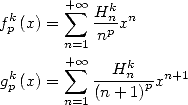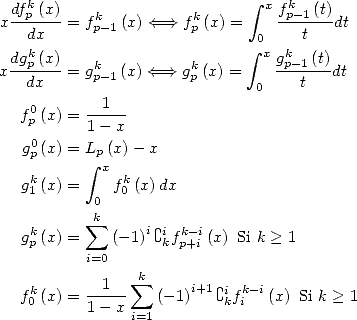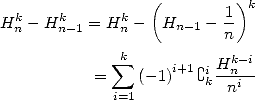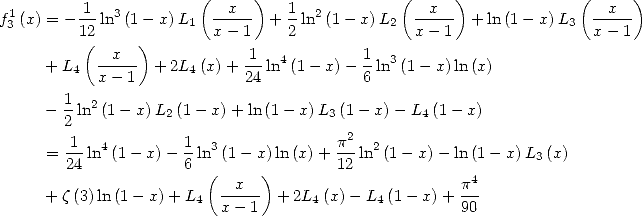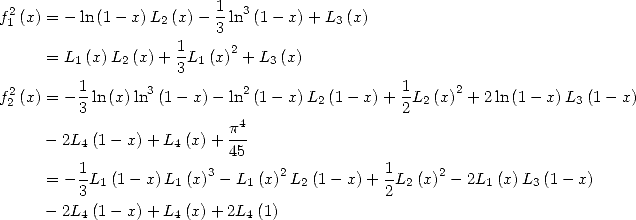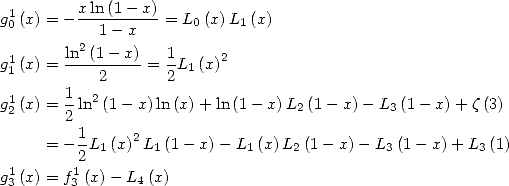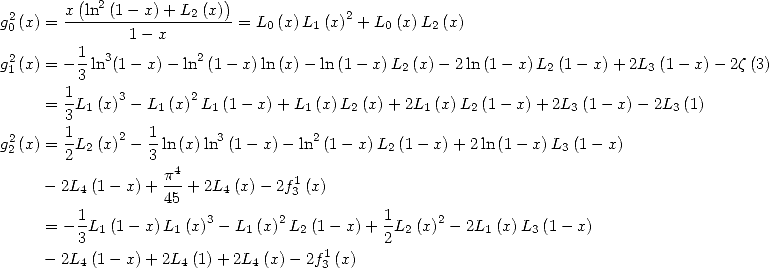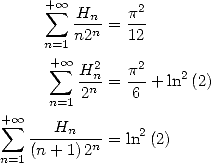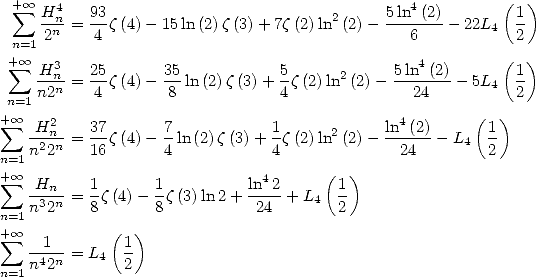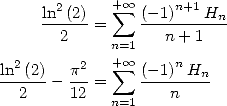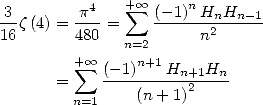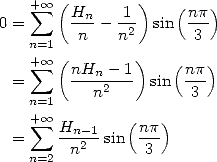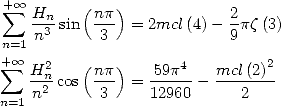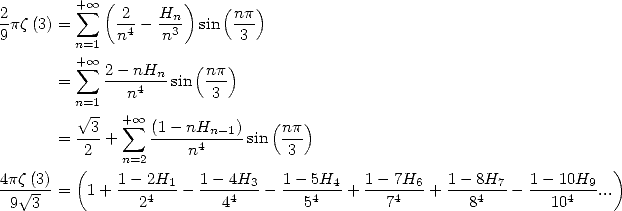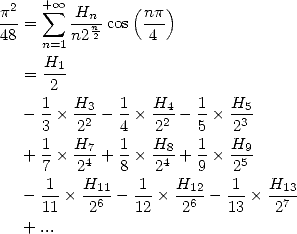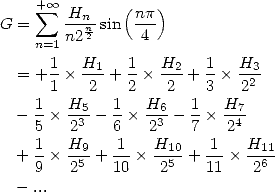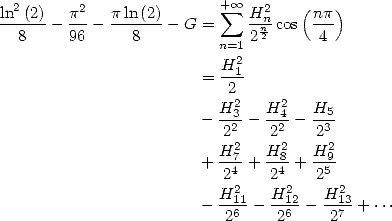|
The world of Pi - V2.57 modif. 13/04/2013 |
|
|
|
13 Harmonic Series
The BBP formulae are expressed for example as linear combination of those hypergeometric functions but even more things await us! Because thanks to integral representation, we can also in fact obtain harmonic series of the same form as all those that we just found.
The harmonic series are those which the terms
contain the harmonic sum  .
.
13.1 Links between harmonic series and the polylogarithms
We have seen that the BBP or factorial
formulae are integral combinations of the kind  .
.
Let us now consider the integral equivalent to
the serie's term of the harmonic sum  . According to the product
formula by Cauchy for which two absolutly convergant series
. According to the product
formula by Cauchy for which two absolutly convergant series  and
and 
 |
(587) |
where  , by choosing
, by choosing  and
and  we get
we get  and so
and so
 |
(588) |
You can start to see what I mean... :-) As soon as an integral uses this
kind of formula, we will have some harmonic lurking in a corner. Here,
we find one immediatly in  the formula
the formula
 |
(589) |
With  we had some polylogarithm (voir 35),
but this doesn't matter, we divide the expression 588 by x ! And then integrating between
we had some polylogarithm (voir 35),
but this doesn't matter, we divide the expression 588 by x ! And then integrating between
 and
and  , we have
, we have
 But,
since
But,
since  , we finaly
obtain that
, we finaly
obtain that
 |
(591) |
Impressive, no? obviously, this remind us of many things, we are swimming in a sea of polylogarithm and logarithm...
We can study in more generality the harmonic series of this kind and the formulae that follows from them by introducing the notations by Gery Huvent (him again !). All the following formulae which are not yet known can be credited to him !
13.2
Study of  and of
and of 
13.2.1 Definition, remarquable relations
We let
Those series have a convergence radius of 1.
The convergence take place on the border as soon as  (because
(because  ). Then
). Then
Proof.
hence
Similarly
 |
(605) |
_
13.2.2 Calculations of certain functions
A usual expansion (donne by Cauchy's product) gives
 |
(606) |
Then by integrations
 |
(607) |
and
 |
(608) |
Before carrying on, let us examine this
equality. For  the serie defining
the serie defining  converges, but the right hand side of the previous equality does not.
However with the formulae by Euler and Landen, we get
converges, but the right hand side of the previous equality does not.
However with the formulae by Euler and Landen, we get
The last equality gives us an expression of  valid for
valid for ![[-1, 1]
2](../mathematiciens/huvent/hyperg1854x.gif) . By analytical expansion, we know
that the different expression obtained coincide where they are defined simultaneously.
. By analytical expansion, we know
that the different expression obtained coincide where they are defined simultaneously.
We will hence use if necessairy different expressions for the
calculations of functions  in
in  and
and  .
.
We deduce from the calculation of  that
that
 |
(611) |
then by integration that
Finaly
 |
(613) |
and hence
We deduce from it that
Then by a differentiation calculation, we have
which gives for real 
and
and finally
13.3 Applications to the calculation of certain series
We use the previous results with some rightly
chosen values for 
13.3.1
With 
The values are more easily obtained with the Beta functions, for example
 |
(628) |
13.3.2
With 
We obtain by taking the value of the
functions  and
and  in
in 
 |
(629) |
By combining, we get
 |
(633) |
Calculation of  for
for 
 |
(636) |
Calculation of  for
for  To sum up :
To sum up :
We can combine those results and obtain
 |
(645) |
13.3.3
With 
The convergence for the serie is no problems
for  we then get
we then get
 |
(646) |
 |
(647) |
For  we find that
we find that
Which gives us
 |
(650) |
Those equalities are justified because
alternating series converges and with of theorem like Tauber, we
conclude.
The two following equalities are formally obtained with Maple, they are
satisfied numerically but I can not yet justify them.
which gives by subtracting them and with 
We also have
 |
(654) |
13.3.4
With 
We then get by considering the real and imaginary parts
The convergence is assured by making  for
for  real and by passing through the limit in
real and by passing through the limit in  with Abel's lemma.
with Abel's lemma.
With  We get taking into account the value of
We get taking into account the value of  and Landen's equality in
and Landen's equality in 
But, we have proved in [12] (calculation of  )
)
 |
(658) |
which gives us
 |
(659) |
and allows us to find with 
 |
(660) |
With  The calculations are a bit more complicated, we
use this time the equality (658),
then the inverse formula for the polylogarithm of order
The calculations are a bit more complicated, we
use this time the equality (658),
then the inverse formula for the polylogarithm of order  which gives
which gives
 |
(661) |
as well as
 |
(662) |
 |
(663) |
which correspond to the calculation of  in my paper ”formules BBP”, we get
in my paper ”formules BBP”, we get
We apply the same substitution for  and
and  . We then obtain by considering the
real part (the imaginary part does not give anything useful)
. We then obtain by considering the
real part (the imaginary part does not give anything useful)
By combining the different equations obtained, we can deduce
 |
(667) |
13.3.5
With 
We use in this case the following result.
If we let
(mgl means "multiple by Glaishers” and mcl means ”multiple by Clausen”) then
where  is the nth polynomial by Bernoulli.
is the nth polynomial by Bernoulli.
Then the duplication formula
 |
(672) |
with  which allows to express
which allows to express  and
and  with the help of
with the help of  and
and  .
.
We then obtain the following results :
With 
 |
(675) |
the convergence of this serie is justified by
summation in different parts.
We also obtain (under the reservation of convergence, but it is at best
very slow that it is hard to check ! ! !)
 |
(676) |
but
 |
(677) |
where
or
 |
(679) |
With 
 |
(680) |
which gives us
 |
(681) |
the convergence of this serie is justified by the summation by parts.
 |
(682) |
which gives
 |
(683) |
we also have
 |
(684) |
With  we obtain the following formula
we obtain the following formula
 |
(685) |
the other make some 
 intervine
intervine
For example
which gives with
 |
(688) |
13.3.6
With
By using the equality
 |
(690) |
and it's conjugate, we have
whose convegence is assured by packets.
By combining with (675), we obtain
 |
(692) |
13.3.7
With 
For  We get with
We get with  the two following formulae which are remarquables
the two following formulae which are remarquables
and with  the two equality
the two equality
 |
(696) |
With the functions  we have
we have
With  The function
The function  gives immediatly
gives immediatly
 |
(698) |
 and
and  gives
gives
13.4 Generalisation
13.4.1 Euler's sums
If we define  (partial sum of
(partial sum of  ), we have Euler's theorem.
), we have Euler's theorem.
If  then
then  is expressed with the help of
is expressed with the help of  and
and 
We have some relations with the polylog :  .
By integrating we have for example
.
By integrating we have for example
 |
(701) |
13.4.2 A formula combining Harmonic and combination
Here is a little serie that I've found recently in novembre 2001, mixing the combinations and the sums harmonic ! We can maybe find a more simple proof, but I do find this one quite elegant in the end.
Ok, it's a particular case, I don't know if we can find other series of this kind (and numerically I have yet to find one), but it is maybe worth the effort of searching!
Proof. Let  . Then
. Then
hence
 |
(704) |
hence in particulae in  and by regrouping the two series containing some
and by regrouping the two series containing some  ,
we obtain
,
we obtain
 |
(705) |
which simplify a bit more the work !
The trick  unfortunatly does not seem useful because the serie in
unfortunatly does not seem useful because the serie in  is difficult to calculate it seems to me.... Let us find another way.
is difficult to calculate it seems to me.... Let us find another way.
Note that we have  i.e.
i.e.  .
.
Hence

using integration by parts. Hence since ![integral [V ~ ------ ] integral
0xua V~ r1cs-inu(2u)du = - 1- u2arcsin (u) x0 + 0xudu](../mathematiciens/huvent/hyperg2002x.gif) using integration by parts, just simply,
using integration by parts, just simply,
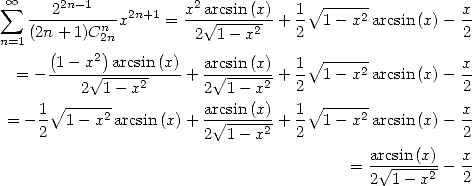
on the convergence radius of ( ).
).
We now need to properly integrate this serie
to find a term in  :
:
 |
(706) |
let us add the term for  :
:
 |
(707) |
We now use 705 to obtain
 |
(708) |
hence finaly
 |
(709) |
_
13.4.3 An other formula
We also find some formulae with some special harmonic sums such as Bradley's formula :
 |
(710) |
or even this representation of  which present some troubling similarity with the previous one !
which present some troubling similarity with the previous one !
 |
(711) |
The proof is available in [10].
13.4.4 Harmonics of harmonics !
According to the Gradshteyn [9] (1.516), we can immediatly obtain
 |
(712) |
back to home page



